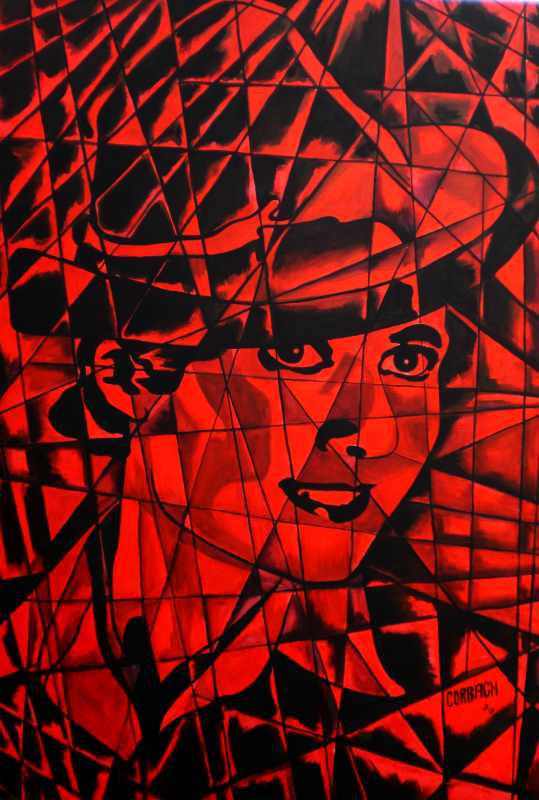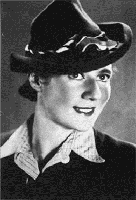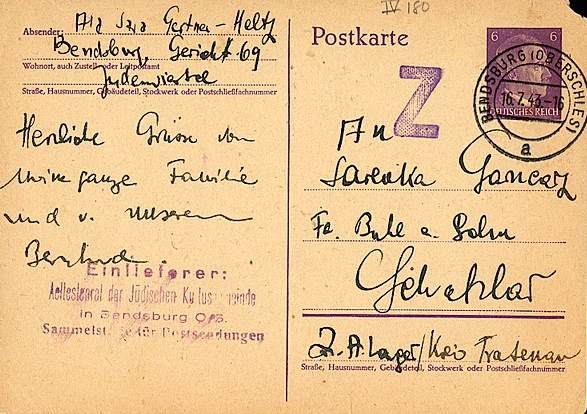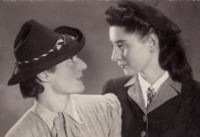
Meinungen aus Kunstnet.de zu diesem Bild:
Von Kunstonsofa:
"Ich musste nach dem Text erst mal tief Luft holen. Dann die fröhliche Frau in einem zerissenen Nest... das Bild ist toll, nur muss man auch die geschichtlichen Hintergründe immer wieder neu verarbeiten... "
Von W999R:
"
Hallo Simone!
Eine mich sehr bewegende Serie,
mit niederschmetternden Texten und wunderbaren Bildern.
Ganz toll!
Herzliche Grüße
Winfried "
Von mad_eye_moody :
"Beeindruckend... und die Geschichte dazu erschütternd.
ich finde die Technik genial, passt zum Text dazu.
Von synafae :
"
Eine tolle Serie, sehr ergreifend... "
 Ala Gertner
Ala Gertner
(geboren am 12. März 1912 in Bedzin, Polen;
ermordet am 5. Januar 1945 im KZ Auschwitz-Birkenau)
Ala Gertner war an den Vorbereitungen zum bewaffneten Aufstand des Häftlings-Sonderkommandos in den Krematorien III und IV im KZ Birkenau durch das Schmuggeln von Sprengstoff beteiligt und wurde nach wochenlanger Folter durch die Lager-Gestapo in einer inszenierten Hinrichtung vor Augen der angetretenen Häftlinge gemeinsam mit drei Mitbeteiligten durch die SS ermordet.
Ala Gertner wurde als eines von drei Kindern einer wohlhabenden Familie in Polen geboren. Ihre Eltern ermöglichten ihr bis zur deutschen Okkupation Polens 1939 den Besuch des Gymnasiums in Bedzin. Am 28. Oktober 1940 wurde sie vom Bahnhof Sosnowiec aus ins Arbeitslager in Geppersdorf (heute Rzedziwojowice) deportiert, wo sie zur Zwangsarbeit beim Autobahnbau durch die Organisation Schmelt gezwungen wurde (Strecke der Autostrada A 4 ). Sie musste dort in der Küche und der Wäscherei arbeiten.
Wegen ihrer Deutschkenntnisse kam sie in die Lagerverwaltung. Dort lernte sie den Mitgefangenen Bernhard Holtz kennen, den sie nach der Entlassung aus der Zwangsarbeit heiratete. Nach einem Zwischenhalt im Sammellager Bedzin wurde sie irgendwann zwischen Juli und August 1944 mit den bis dahin Überlebenden dieses Ghettos ins Konzentrationslager Auschwitz deportiert. In Auschwitz wurde Gertner zur Arbeit in der Effektenkammer beim Sortieren der Habe inzwischen vergaster Häftlinge gezwungen.
Sie lernte dort u. a. Rózia Robota kennen und freundete sich mit ihr an. Robota war Mitglied einer geheimen Widerstandsgruppe des Lagers. Ala Gertner kam dann ins Büro der Union-Munitionsfabrik . Dort beteiligte sie sich monatelang mit anderen am Schmuggel von Sprengstoff zu den Häftlingen des Sonderkommandos, um einen Ausbruch vorzubereiten. Es gelang ihr, weitere Frauen für die gefährliche Mitarbeit an diesem Plan zu gewinnen. Zusammen mit ihr wurden Rózia Robota, Regina Safirsztajn und Ester Wajcblum hingerichtet.
Ala Gertner konnte aus dem Arbeitslager 28 Briefe an Sala Kirschner (geborene Garncarz) schicken, die überliefert sind. Verwandte, die überlebt haben, sind nicht bekannt. Am 7. Oktober 1994 wurde bei einer Gedenkveranstaltung zum 50. Jahrestag des Sonderkommando-Aufstands im Staatlichen Museum Auschwitz-Birkenau eine Gedenktafel zu Ehren von Roza Robota, Ala Gertner, Esther Wajcblum und Regina Safirsztajn im Stammlager Auschwitz enthüllt. Weitere Gedenkstätten gibt es in Israel und Australien. Der letzte bekannte Brief von Gertner aus Bedzin an Sala Garncarz lautete:
“Kamionka
15. Juli 1943
Liebste Sarenka,
Bin gerade im Postamt, heute soll Post abgehen und wie könnte ich da nicht an meine liebe Sara schreiben? Mein kleiner Bernhard war zu Besuch. Es scheint ihm gut zu gehen und er fühlt sich in Ordnung. Gerne wüßte ich, wie es Dir geht?
Wir alle sind ok und rechnen damit ins Lager zu kommen. Heute ist ein irgendwie seltsamer Tag, aber wir sind guten Muts und zuversichtlich. Verzweifle nicht, es wird alles gut werden. Kopf hoch, es wird schon werden. Herzliche Grüße von der ganzen Familie und von meinem Bernhard
Es küßt dich Deine kleine Ala”
Quelle: http://de.wikipedia.org/wiki/Ala_Gertner

Ala`s Handschrift...
 Ala und ihre beste freundin Sala
Ala und ihre beste freundin Sala
Excerpted from “Sala's Gift: My Mother's Holocaust Story”
______________________________________________________________________________
 Ala Gertner
Ala Gertner
(born in March 12, 1912 in Poland – killed January 5, 1945 in Auschwitz)
On October 28, 1940 she was ordered to report to the train station in nearby Sosnowiec , where she was taken to a Nazi labor camp in Geppersdorf (now Rzedziwojowice ), a construction site where hundreds of Jewish men were forced laborers on the Reichsautobahn (now the E22 highway ) and women worked in the kitchen and laundry. Gertner, who was fluent in German , was assigned to the camp office, where her colleague and friend was Bernhard Holtz , whom she would later marry.
Geppersdorf was part of Organisation Schmelt , a network of 177 labor camps under the administration of Albrecht Schmelt , a World War I veteran who joined the Nazis in 1930 and rose quickly to the post of SS Oberführer . Because of his familiarity with the local political and social conditions in the annexed region of western Poland, Schmelt was handpicked by SS head Heinrich Himmler to be "Special Representative of the Reichsführer SS for the Employment of Foreign Labor in Upper Silesia ." After his official appointment in October 1940, Schmelt set up headquarters in Sosnowiec and created a labor camp system that would become known as Organisation Schmelt. Schmelt built a highly lucrative slave trade. Over 50,000 Jews from western Poland were forced to work for German businesses, primarily in construction, munitions, and textile manufacturing.
The businesses paid Schmelt, who shared a fraction of the money with Moses Merin , the Jewish governor of the region. Almost none of it went to the Jewish laborers. Conditions varied, but were much better than in the large concentration camps : for example, mail and packages could be received in some of the Schmelt camps until 1943, when the Schmelt labor camps became part of Auschwitz and Gross-Rosen . ( Oskar Schindler 's camp was originally under Organization Schmelt.) In 1941, Gertner was allowed to return home. She was employed in various local workshops and offices run by Moses Merin.
She and Bernhard Holtz were married in the Sosnowiec ghetto of Srodula on May 22, 1943. They lived in the Bedzin ghetto of Kamionka until sometime after July 16, 1943 (the date of Gertner's last known letter) and were probably deported to Auschwitz with the remaining Jews of Sosnowiec and Bedzin in early August, 1943.
At Auschwitz, Gertner worked in the warehouses at first, sorting the possessions of Jews who had been gassed. She became friendly with Roza Robota , who was active in the underground resistance. Gertner was then assigned to the office of the munitions factory, where she and Roza became part of a conspiracy to smuggle gunpowder to the Sonderkommando , who were building bombs and planning an escape. Gertner recruited other women to join the conspiracy, and passed the stolen gunpowder to Roza. On October 7, 1944 the Sonderkommando blew up Crematorium IV, but the revolt was quickly quelled by the armed SS guards. A lengthy investigation led the Nazis back to Gertner and Roza, and then to Estusia Wajcblum and Regina Safirsztajn , who were also implicated in the conspiracy. They were interrogated and tortured for weeks. On January 5, 1945 the four women were publicly hanged in Auschwitz.
This was the last public hanging at Auschwitz two weeks
later, the camp was evacuated. Gertner left no known survivors or family,
but her 28 letters to Sala Kirschner (née Garncarz) are among the
350 wartime letters that are in the permanent Sala Garncarz Kirschner
Collection of the Dorot Jewish Division of the New York Public Library
. [4] The heroism of the four women was recognized in 1991 with the dedication
of a memorial at Yad Vashem in Jerusalem .
This is the text of Gertner's last known letter:
“Kamionka
July 15, 1943
Dearest Sarenka,
Suddenly I'm here at the post office. The mail is going out today and how could I not write to my Sarenka? Just now, my husband, little Bernhard was here. He looks good and feels well. I'm curious about how you are, how your health is.
We are well and plan to go to the camp. Today is a gorgeous day, we are in the best of spirits and have great hopes for the future…
Don't worry, girl, it'll be fine.
Be brave, stay well.
Warm regards from my entire family and our Bernhard.
Kisses, your little Ala “
Quelle: http://en.wikipedia.org/wiki/Ala_Gertner

Ala`s Handwriting
Excerpted from “Sala's Gift: My Mother's Holocaust Story”

Ala and her girlfriend Sala